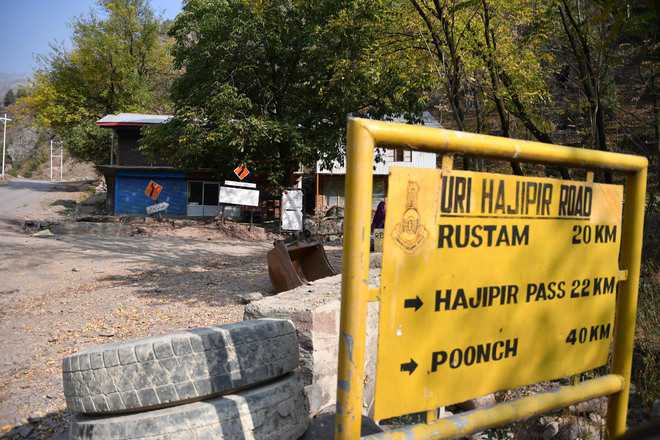Ishfaq Tantry
Tribune News Service
Danna (Zero Line), Uri, Dec 5
“The gate at the fence places our village in no man’s land. Beyond it lies freedom and a different world altogether,” says Fayaz Ahmad Dar (42) of Sahoora, a village situated on a ridge on Zero Line in the strategic Hajipir sector of Uri.
Sahoora village is located 10 km from Uri town and up above in forests on the left side of the Srinagar-Muzaffarabad road. The Hajipir nullah serves as the only geographical barrier that separates the hamlet from PoK.
Just like Hathlanga, Sallikote, Tullawari and Churunda villages of Uri, which are located on Zero Line, Sahoora has been completely left out beyond the barbed fence demarcating the LoC.
The overlooking Pakistani posts, falling in the Sajiwad area of PoK atop a mountain ridge across the Hajipir nullah, serve as a constant reminder to the villagers of the lurking danger. Before the 2003 ceasefire agreement, these Pakistani posts that also overlook the strategic Rustum post on this side had engaged in heavy mortar shelling on villages in Uri.
“I was washing utensils outside my house one day when I heard a loud bang. I rushed to the basement, thinking Pakistan had started shelling,” says Zahida, a resident of Dhana village, while pointing towards Pakistani posts visible from the spot. Zahida lost her mother-in-law and father-in-law to shelling by Pakistan in June 2000.
Between the two tiers of the fence crossing these villages, swathes of agriculture and horticulture land have been mined by the security forces to prevent infiltration, which has picked up in the Uri region the 2016 Uri attack. This year, five infiltration bids have been foiled by the Army in the Uri sector.
“The gate opens at 6 am and closes in the evening. If we want to move out to the market in Uri, we have first to seek permission from the sentry,” says Fayaz, who lost his leg in a mine blast in February 2006. One of the fence lines bisects his compound too. His mother and aunt were also injured in a mine blast, but like majority of such victims, no compensation has been paid to them.
“I lost my father, mother and brother to shelling by Pakistan in June 2000. I was also injured and doctors had to amputate my left leg. It’s been 17 years but I have not been compensated so far,” rues Nasreen, 23, of Danna village in the Hajipir sector.
Of the 150 persons living in Sahoora, six have been disabled in mine blasts. In the neighbouring Dulanga village, there are over 10 such victims.
A majority of children are school dropouts. Villagers whose agriculture land has come under the fence complain that despite surveys and assurances by the officials and politicians, no compensation has been paid to them.
A police officer says recently, a man from Uri crossed over to Pakistan. He said police and other security agencies maintain a record of Sahoora, Silikote, Hathlunga and Tullawari and every movement in these villages is closely monitored.
Migration in 1990s
Like other 40 villages in Uri tehsil, Sahoora was once a bustling village, where majority of people engaged in farming and took care of their walnut orchards. But as the militancy erupted in the Kashmir valley and hostilities between India and Pakistan broke out on borders in the early 1990s, almost everyone from the village migrated to Pakistan. As per the police records, 200 families of Sahoora village crossed over to the other side in the Bagh district of PoK, leaving just 13 families behind. As per the 2011 Census, Sahoora today comprises 21 families.
This side of the fence
Village Population Literacy rate (in %)
Male Female
Sahoora 150 74.47 51.35
Salli Kote 194 91.25 80.43
Hathlanga 539 66.52 42.97
Churunda 1,169 62.7 25
Tullawari 476 80.84 55.21
Unlock Exclusive Insights with The Tribune Premium
Take your experience further with Premium access.
Thought-provoking Opinions, Expert Analysis, In-depth Insights and other Member Only Benefits
Already a Member? Sign In Now










